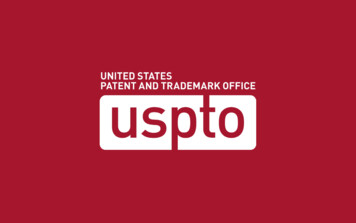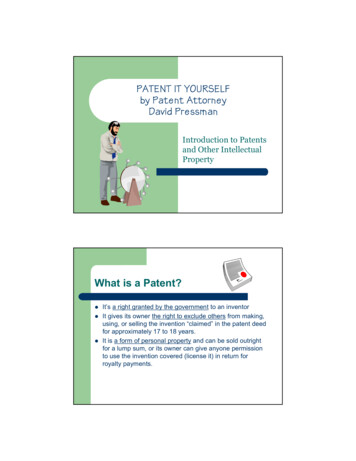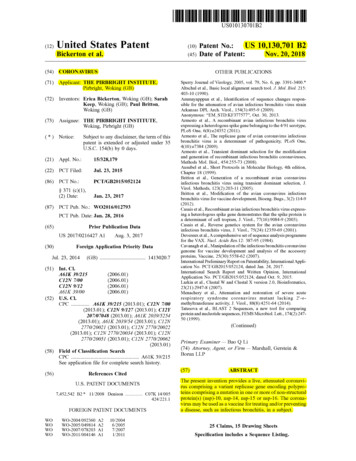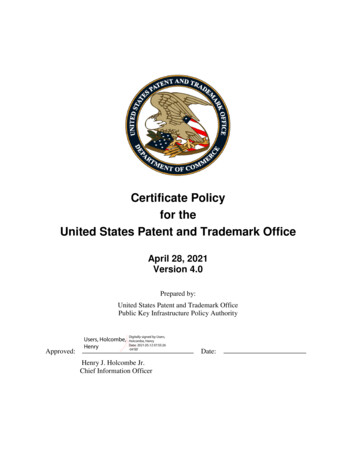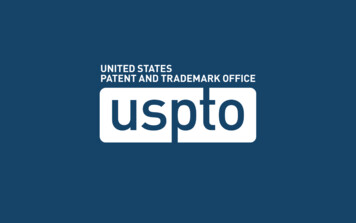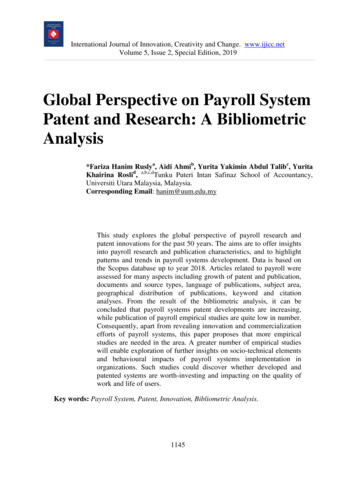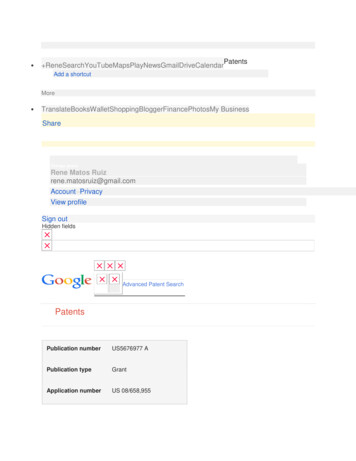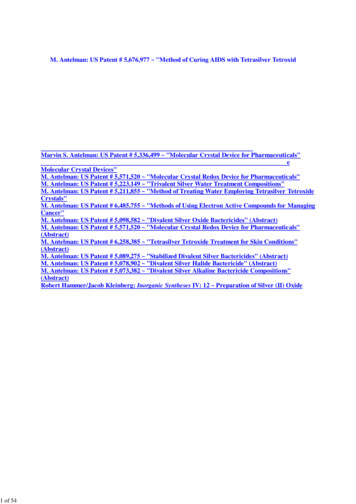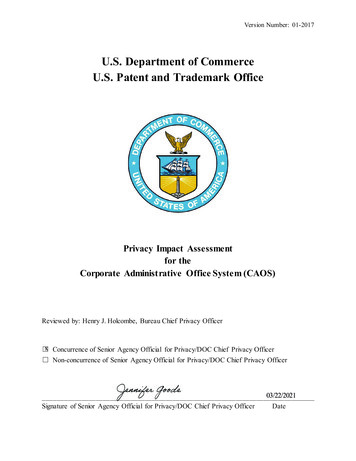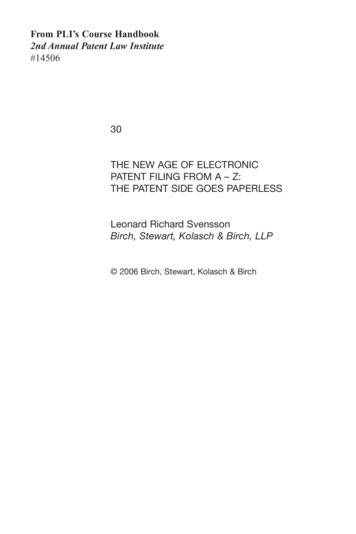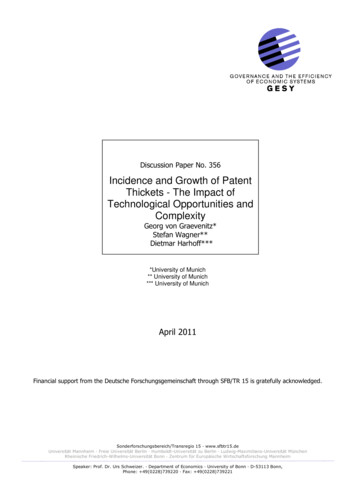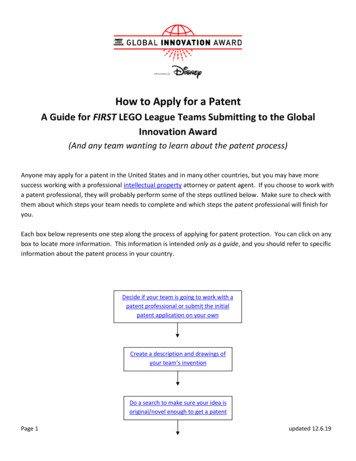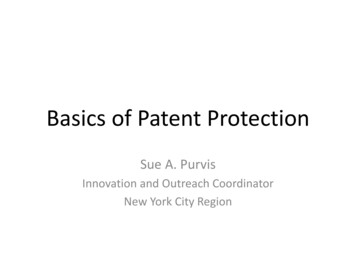
Transcription
Basics of Patent ProtectionSue A. PurvisInnovation and Outreach CoordinatorNew York City Region
Outline Overview of Intellectual PropertyWhat is a Patent?Why get a Patent?Who can file for a Patent?Types of PatentsRequirements for PatentabilityHow is a Patent granted?How long does it take to get a Patent in the United States?Patenting ConsiderationsTrade Secret vs. Patent2
Overview of Intellectual PropertyWhat’s Protected?ExamplesProtection Lasts for:UtilityPatentInventionsiPod, chemical fertilizer,process of manipulatinggenetic traits in mice20 years from the date offiling regular patentapplicationDesignPatentOrnamental (non functional)designsUnique shape of electricguitar, design for a lamp14 yearsCopyrightBooks, photos, music, fine art,graphic images, videos, films,architecture, computerprogramsMichael Jackson’s Thriller(music, artwork and video),Windows operating systemThe life of the author plus 70years (or for some works, 95years from first publication)TradeSecretFormulas, methods, devices orcompilations of informationwhich is confidential and givesa business an advantageCoca‐Cola formula, surveymethods used by a pollster,new invention for whichpatent application has notbeen filedAs long as informationremains confidential andfunctions as a trade secretTrademarkWords, symbols, logos,designs, or slogans thatidentify and distinguishproducts or servicesCoca‐Cola name anddistinctive logo, Pillsburydoughboy characterAs long as businesscontinuously uses trademarkin connection with goods orservices3
Some IP found in a mobile phoneTrademarks: Made by "Nokia" Product "N95" Software "Symbian", "Java"Patents: Data-processing methods Semiconductor circuits Chemical compounds Battery/Power Control AntennaCopyrights: Software code Instruction manual Ringtone NokiaTrade secrets: ?Designs (some of them registered): Form of overall phone Arrangement of buttons in oval shape Three-dimensional wave form of buttons Sliding screen4
What is a Patent? A Property Right– Right to exclude others from making, using,selling, offering for sale or importing theclaimed invention– Limited term– Territorial: protection only in territory thatgranted patent; NO world‐wide patent5
Quid Pro QuoTime‐LimitedMonopolyDiscloses Invention6
Role of the Patent SystemProtect InventionsEncourage InventionsPromote commercialization and application ofinventionAccelerate the commercialization of invention to thewhole society7
First U.S. PatentPatent No x-1(July 31, 1790)Signed byGeorge Washington8
Why Get a Patent? A patent can be– Used to gain entry to a market– Used to exclude others from a market– Used as a marketing tool to promote uniqueaspects of a product– Sold or licensed, like other property9
Who Can File for a Patent? Anyone from anywhere may apply, with only oneexception:– Officers and employees of the USPTO35 U.S.C. §4 ‐ Restrictions on officers and employees as to interest in patentsOfficers and employees of the Patent and Trademark Office shall beincapable, during the period of their appointments and for one yearthereafter, of applying for a patent and of acquiring, directly orindirectly, except by inheritance or bequest, any patent or any right orinterest in any patent, issued or to be issued by the Office An assignee, a person to whom the inventor is underan obligation to assign, or a person who otherwiseshows sufficient proprietary interest10
Basis for Protection of Patents andCopyright in the U.S.US Constitution, Article 1, Section 8, Clause 8–“Congress shall have the power . to promote theprogress of science and useful arts, by securing for limitedtimes to authors and inventors theexclusive right to their respectivewritings and discoveries.”11
Overview of Patent LawSources of Law Statutory– 35 U.S.C. (Patent Code) Rules: 37 C.F.R. (Patent Regulations)– Rules governing the operation of the USPTO; maybe changed by the USPTO following the properprocedure Case Law– The United States has a common law system– Court cases shape the interpretation of laws12
Types of U.S. Patents Utility – How an invention works– Inventions– Functionality– 20 year term from filing date Design – How it looks– ornamental design described & shown– 14 year term from grant date Plant – new variety of asexually reproduced plant.– 20 year term from filing date13
Utility Patent14
Design Patent Protects the way an article looks, including– its shape and configuration, as well as– surface ornamentation applied to the article15
Plant Patent PP20,90016
Requirements for Patentability35 USC §101 – Utility, Statutory Subject Matter35 USC §112 (a) – Enablement, writtendescription, and best mode35 USC §112 (b) – Definiteness35 USC §102 – Anticipation35 USC §103 – Obviousness17
35 U.S.C. 101“Whoever invents or discovers any new anduseful process, machine, manufacture, orcomposition of matter, or any new and usefulimprovement thereof, may obtain a patenttherefore, subject to the conditions andrequirements of this title.”18
Utility PatentsProcess/method/UseCompositionof Matter/Product/ManufactureTypes ofInventionsMachine/apparatusImprovementthereof19
35 U.S.C. 112 (a) The specification shall contain– a written description of the invention, and of– the manner and process of making and using it,– in such full, clear, concise, and exact terms as to enableany person skilled in the art to which it pertains, or with which it is most nearly connected, to make and use the same,– and shall set forth the best mode contemplated by the inventor of carrying out his invention20
35 U.S.C. 112 (b) The specification shall conclude with– one or more claims particularly pointing out and distinctly claiming the subject matter which the applicant regards as hisinvention21
35 U.S.C. 102 35 U.S.C. 102 ‐ an invention must be new– An invention lacks novelty (i.e., is “anticipated”) only if each and every element as set forth in the claim is found, either expressly or inherently, in a single prior art reference– Reference must teach every aspect of the claimedinvention either explicitly or impliedly Any feature not directly taught must be inherently present22
35 U.S.C. 103 35 U.S.C. 103 ‐ an invention must be non‐obvious– More than a mere obvious modification of the prior art– Reference teachings must somehow be modified to meet theclaims Modification must be one which would have been obvious to one ofordinary skill in the art at the time the invention was made– The teachings of multiple references may be combined under§ 10323
It’s all about the claims! Protection is limited to what is claimed During prosecution, claims are searched, may be rejected,amended, and allowed Specification may include numerous embodiments andelements– but only subject matter claimed is afforded protection Examiner works with the Applicant to focus the claims on novelaspects of the invention Broadest reasonable interpretation during examination– Search of invention may extend to unrelated areas24
37 CFR 1.77(a): Elements of an Application1.2.3.4.Utility application transmittal form.Fee transmittal form.Application data sheet – bibliographic information.Specification.‐‐Abstract, title, cross‐references to related applications,background of invention, summary of invention, briefdescription of drawings, detailed description, claims, etc.5. Drawings (if necessary).6. Executed oath or declaration.25
Flowchart of Patent Examination and Appeal System(I) Patent ExaminationClassification determinesTC/AU for examinationPatent ExaminationFirst Action On the Merits(FAOM)Notice of AllowanceApplicant(s) ResponseApplication undergoesPre‐ExamApplicant(s) pay issue feeFinal RejectionApplicant(s) ResponseAdvisory ActionApplicant(s) Appeal26
Flowchart of Patent Examination and Appeal System, cont.(II) Appeal ProcessExaminerReversedApplicant(s)AppealNotice of alApplicant(s)Appeal Court of Appeals for theFederal Circuit (CAFC) U.S. District Court for theEastern District of Virginia(E.D. Va)Supreme Court27
Patent Examination Patent Examiner reviews contents ofthe application for compliance with allU.S. legal requirements Burden is on the examiner: Anapplicant is entitled to a patentunless – Requirements of U.S. Law are not met28
Prior Art ‐ 35 U.S.C. 102 &35 U.S.C. 103 Prior Art– Any information available for considerationwhen determining whether an invention ispatentable– Public information Patents, publications, articles, products,information on the internet, etc. Printed publications – U.S. or foreign– Information available/dated before the filingdate of application being examined29
Examiners search the prior art30
Other Types of Prior Art in the U.S. Prior sales or public use in the United States– If the U.S./foreign patent/publication or publicuse/sale in the U.S. is more than one year beforethe effective filing date Applicant is barred from obtaining a patent AIA Changes to Prior Art (March 16, 2013)– Prior public use or sale anywhere in the world qualifies asprior art31
Grace Periods Time prior to filing during which public disclosureby an inventor will not be considered prior art Differs in different jurisdictions.– U.S.: 1 year grace period (35 U.S.C. 102(b))– EU: No grace period.– JPO: 6‐month grace period, under certaincircumstances32
Public Search Page33
Public PAIR34
How long does the process take? Utility Patents– 18.7 months avg. for a first office action– 30.6 months avg. for total pendency Design Patents– 13 months avg. for total pendency Time can vary depending on the technologyand amount of prosecution– 597,318 application backlog 7,734 Patent Examiners(May 2013 statistics)35
Where to Patent? Patent protection can be an important part ofoverall business strategy in global marketplace Patent rights are territorial– Protection against infringing activities Only within the country or region in which patent wasgranted NO world‐wide patent– Must apply for and be granted a patent in each country orregion of interest36
Patenting Considerations Conduct cost/benefit analysis– Consider the shelf life of a product, e.g., changes in technology, style– Consider how the patent will be used, e.g. licensing, to excludecompetitors– Consider whether the product can be used outside your market Determine patentability– Searching yourself vs. engaging a professional searcher Choose right patent attorney/agentPreparation of a thorough and accurate applicationAre there workarounds for the invention?Costs – Patents can be expensive.– Background work can help to keep attorney fees lower– Annuity & Maintenance fees37
How much does it cost?Fees USPTO Utility application––––––Filing feeSearch feeExamination feeDiscount for small entitiesIssue FeeMaintenance Feesdue at 3 ½ , 7 ½ & 11 ½years Attorney fees– Hourly fees– Flat Rates Design Patents– No maintenance fees– 2,000‐ 3,000Cost varies based on amount of prosecution. 5,000- 25,00038
Provisional Patent Application A low‐cost way to establish an early effective filing date (prioritydate) in a non‐provisional patent application with fewer formalities– Specification & Drawings– No claims required 12 month window to file a corresponding utility patent applicationin order to benefit from the priority date of the provisionalapplication Caution – will lose priority date for any new matter filed in the utilityapplication Provisional application is abandoned automatically at 12 monthsand is not examined39
Patent Infringement in the U.S.Occurs when –Without authorization of patent owner:– Making or using the invention– Offer to sell or sells within the U.S.– Import the invention into the U.S.– Actively induce infringement by another40
Enforcement Considerations Enforceability of patents– Effectiveness of enforcement laws and procedures in thecountry/region of interest Some countries allow recordation of patent withcustoms Enforcement requires patent owner action Competitor products should be monitored– In stores– At trade shows Licensing may be beneficial– Limit as to time, geographical area, or field of use41
Trade Secret Law Protects a commercially valuable proprietary information Valuable business information that gives a competitiveadvantage Trade Secrets are not generally known and must besubject to reasonable efforts to preserve confidentiality Examples––––––Formulas (e.g. Coca‐Cola )Manufacturing processesBusiness strategiesBusiness management informationCustomer listsDesign concepts42
Trade Secret vs. PatentTrade Secret IndefiniteNot registered or disclosedCan be separately discoveredRemedy only if the secret isillegally appropriatedPatent 20 year termPublic disclosureRight to exclude othersRemedy for infringement43
Common Ways to Lose a Trade Secret Owner or owner‐authorized disclosure Reverse engineering Independent development Failure to take adequate steps to preventdisclosure44
www.Espacenet.com European PatentOffice Worldwidesearch 80 countries WIPO search forPCT applications45
Resources http://www.uspto.gov/inventors/index.jsp– Inventors Resources on PTO Internet site http://patft.uspto.gov/– Searching US patents http://www.uspto.gov/patents/init events/pct/index.jsp– PCT Legal Web site http://www.StopFakes.gov– Protecting Intellectual Property Rights property– Office of US Trade Representative http://www.wipo.int– World Intellectual Property Organization http://www.espacenet.com/access/index.en.html– European patent database http://www.ipdl.ncipi.go.jp/homepg e.ipdl– Japanese patent database46
THANK YOUsue.purvis@uspto.govwww.uspto.gov/cornell
– Consider how the patent will be used, e.g. licensing, to exclude competitors – Consider whether the product can be used outside your market Determine patentability – Searching yourself vs. engaging a professional searcher Choose right patent attorney/agent
